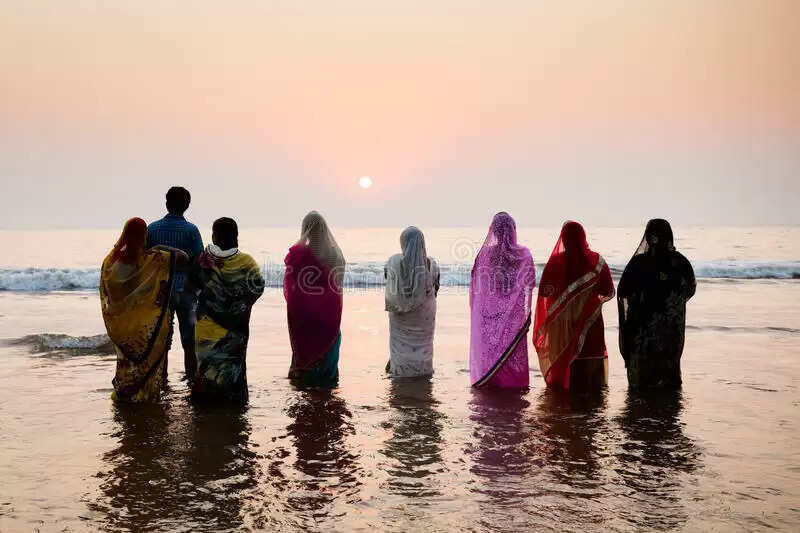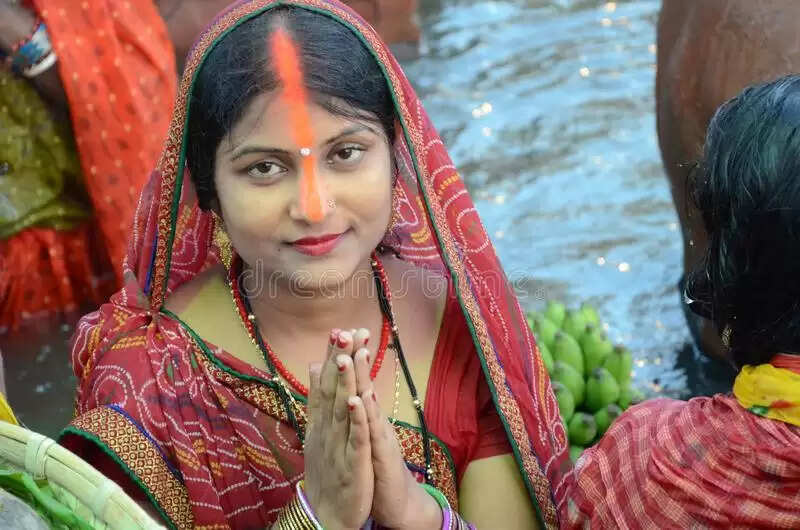Chhath’ Festival ends after 2nd ‘Argha’ to rising Sun today in Gaya
 GAYA(Bihar): The three- day ‘Chhath’ festival ended after devotees offered a second “argha” to the rising sun on Monday in Falgu river and different ponds this morning.
GAYA(Bihar): The three- day ‘Chhath’ festival ended after devotees offered a second “argha” to the rising sun on Monday in Falgu river and different ponds this morning.“The Chhath is generally celebrated in Bihar and Purvanchal (east) Uttar Pradesh where people pray for the sun, the only god visible in the universe,” said a devotee named Rahul Kumar in Gaya's Delha.
‘Chhath” is celebrated among all sections of the society across the world where people of Bihar or Purvanchal regions.Gaya DM Dr Tayagrajan SM, Gaya's SSP Harpreet Kaur other top officials of Gaya and thousand of devotees have also given “Argha” to the rising sun in falgu river in Gaya.
Gaya police have made elaborate security arrangements for the Chhath Puja celebrations organised from October 28 to 31th October 22, SSP Harpreet Kaur said.
In a recent meeting, Gaya SSP Harpreet Kaur asked all Officers in Charge of Gaya district police to ensure an incident-free festival.

“We have deployed extra security personnel at all Chhath Puja ghats across the city. We had a meeting with puja organisers and we asked them to ensure installation of CCTVs, deployment of private security guards and volunteers to manage visitors,” said SSP.“We have ordered deployment of more police personnel and patrolling in and around Chhath Puja route as most of the devotees will camp at the ghats overnight and return home after offering prayers to the rising sun on Sunday morning,” added SSP Kaur.
The 36- hour- long fast of Chhath is said to be the hardest vrat of the festival and is only completed after Usha Arghya, which is the fourth day of the auspicious festival. On the final day of Chhath on Monday ie October 31th also known as Parana Din, devotees offer Usha Arghya or Dusri Argya to the rising sun.
The ritual is done while standing with the feet dipped in a water body. After this, devotees conclude their fast and distribute prasad.Meanwhile, Parana means the ritual of breaking the fast. According to Hindu rituals, Parana time is considered to be the most auspicious and sacred time, when the devotees break their fast after performing the last rituals of Chhath Puja and offer bhog prasad and fruits to Lord Surya and Chhathi Maiya.
Chhath Puja is the most prominent festival which is celebrated in the North Indian state of Bihar and certain regions of Uttar Pradesh and Nepal. Chhath is a famous festival which starts on the 6th day of the Hindu calendar month “Kartika”. This festival is dedicated to the worship of the Sun god and his wife Usha.
This festival is celebrated to thank god for supporting life on earth and to seek the blessing of divine Sun god and his wife. According to Hindu religion, it is believed that sun heal several health conditions and offers longevity, progress, positivity, prosperity and well being. Moreover, the main day of Chhath is actually not the first but the third day of Chhath Puja.
This festival is celebrated by people following rigorous routine which lasts for four days, the rituals and traditions of this festival includes fasting , offering prayers to the rising and setting sun, holy bathing and meditation while standing in the water. It is one of the famous Indian festivals which are celebrated in Bihar and many other destinations of India including Jharkhand, eastern UP, Madhya Pradesh, Uttar Pradesh, Bangalore, Chandigarh, Gujarat, Bangalore, Chhattisgarh and regions of Nepal.
It is celebrated at the sixth of the month of Karthika in the Vikram Samvat. Chhath Puja is also celebrated in the summers after Holi but the Chhath which is celebrated in Kathika month has more importance and is ardently followed by people.
History of Chhath PujaChhath is a festival which is all about purity, devotion and offering prayer to Sun God; the exact origin of this festival is ambiguous but there are certain believes which connects to Hindu epics. Ramayana and Mahabharata are the two epics which are associated with Chhath Puja.
Chhath Puja’s Association with Ramayana
It is believed that Lord Rama is associated with the inception of Chhath Puja. It is said that when Lord Rama returned to Ayodhyana then he and his wife Sita observed a fast in honor of the Sun god and broke it only with the setting sun. It is one such ritual which is subsequently evolved in Chhath Puja.Chhath Puja’s Association with Mahabharata
Famous Mahabharata character Karna is said to be the child of Sun god and Kunti. It is said that Karna usually use to offer prayer while standing in the water. However, there is another story which mentions how Draupadi and the Pandavas also performed the similar puja to get their kingdom back.Scientific Significance of Chhath Puja
Chhath Puja is the best way to get your body detoxified as taking dips in water and exposing the body to sun increases the flow of solar bio electricity which improves the functionality of human body. It is also said that Chhath Puja helps to kills the harmful bacteria and prepares the body for the upcoming winter season.
Rituals Involved in Chhath Puja
Chhath is a four day festival which starts four days after the famous Indian festival Diwali, this year Chhath Puja 2022 is in October month. Below is the list of Chhath rituals which are involved in Chhath Puja.Day1
Nahay Khay( October 28, 2022) The first days of the Chhath Puja involved devotees taking dip preferably in the river falgu, and other ponds and then after the holy dip devotees take home the holy water to prepare the offerings. It is one of the most important rituals of Chhath Puja on the first day.
Day2Lohanda or Kharna ( October 29 ) The second day of Chhath Puja involved devotees fasting the whole day and the fast ends a little later after the sunset. The second important ritual of Chhath Puja involves devotees preparing offerings like kheer, bananas and rice for the family after worshiping the Sun and the Moon. After consuming the prasad one has to fast for 36 hours without water.
Day3
Sandhya Arghya (evening offerings, October 30 ): The third day of Chhath Puja is also observed with fast without water and the entire day involves preparing puja offerings. The offerings (prasad) later are kept in a bamboo tray. The offering includes thekua, coconut banana and other seasonal fruits. Third day’s evening rituals takes place at the banks of a river or a pond or any clean water body. All the devotees offer ‘araghya’ to the setting sun.
Day4
Bihaniya Arghya: On the last day of Chhath Puja, devotees again assemble on the bank of the river falgu or any water body and then offer prayers and prasad to the rising Sun. After the offerings are done then the devotees break their fast by eating ginger and sugar or anything which is available locally. After all these Chhath Puja rituals this amazing festival ends.
